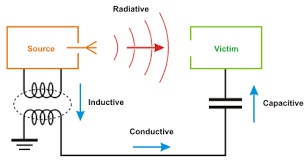WHAT IS PCB AND ITS TYPES?
As
electronics moved from vacuum tubes and relays to silicon and integrated
circuits, the size and cost of electronic components began to decrease.
Electronics became more prevalent in consumer goods, and the pressure to reduce
the size and manufacturing costs of electronic products drove manufacturers to
look for better solutions. Thus was born
the PCB.
PCB is an acronym for printed circuit board. It
is a board that has lines and pads that connect various points together. In the
picture above, there are traces that electrically connect the various
connectors and components to each other. A PCB allows signals and power to be
routed between physical devices. Solder is the metal that makes the electrical
connections between the surface of the PCB and the electronic components. Being
metal, solder also serves as a strong mechanical adhesive.
PCBs may be classified in many different ways according to their
various attributes. One fundamental structure common to all of them is that
they must provide electrical conductor paths that interconnect components to be
mounted on them.
There are two basic ways to form these conductors:
1. Subtractive. In the
subtractive process, the unwanted portion of the copper foil on the base
substrate is etched away, leaving the desired conductor pattern in place.
2. Additive. In the
additive process, formation of the conductor pattern is accomplished by adding
copper to a bare (no copper foil) substrate in the pattern and places desired.
This can be done by plating copper, screening conductive paste, or laying down
insulating wire onto the substrate on the predetermined conductor paths.
(1) Single sided PCB
Single sided board means the conductor pattern appears only on
one side. Because single sided PCB has many strict limits. On trace design,
only circuit at early stage use this kind of boards.
(2) Double sided PCB
Double sided board means the conductor patterns appear on both
sides of the board. However if we use the conductor patterns on both sides,
there should be proper circuit to connect two sides. The bridge between the
circuits is called via. Those vias are plated with metal, such as tin, copper,
gold, etc. Because the area of double sided PCB is two fold of the area of
single sided, and the conductor pattern can cross with each other, so it suits
to be used on more complex circuits.
(3) Multi-layer boards
In order to enlarge the area of conductor pattern, multilayer
PCB uses more single or double boards. It uses several piece of double sided
boards, and a dielectric layer is put between every layer of boards. The layers
of one PCB represent the layer of conductor patterns. The amount of the layers
is always even number. Technically we can make PCBs up to 100 layers.
For via, if we use it on double sided PCB, the whole boards will
be drilled. While on multilayer PCB, if you just want to connect some traces,
via may will waste trace space of some layers. Then we use buried vias and
blind vias to solve this problem, because they are only drilled through several
layers.
a. Buried vias only connect inner
PCBs, so we can’t see them from the surface.
b. Blind vias connects several layers
PCB with surface PCB.
In multilayer PCB, the whole board directly connects the ground
line and power (used for preventing affection of the transmission signals on
the signal). So we divide layers into signal, power, or ground. If the components
on PCB need different power supply, this kind of PCB would have more than two
layers of power and wire layers.




small discription about PCB
ReplyDelete"Significance of AOI in PCB Manufacturing Process - PCB Power Market"
ReplyDelete"Irrespective of the goal of having a printed circuit board or PCB in a device, it is imperative that the PCB functions properly. As the performance of a product depends primarily on its PCB, malfunctions can be serious.
To ensure the PCB will function as intended, manufacturers inspect it at different stages throughout the design, fabrication, and assembly processes. Inspection is a crucial activity for ensuring the product not only operates as expected, but also meets quality standards. The increasing complexity of PCBs today leads to new capabilities, and at the same time, gives rise to higher chances of failure. Therefore, inspection techniques and technologies have also evolved to keep pace and to ensure the quality.Inspection helps to locate defects, and correcting them leads to an overall improvement of the operation. It also helps in revealing existing design flaws. Inspecting PCBs after each phase of the process enables locating flaws before moving on to the next stage. Correcting the process for eliminating flaws requires much less effort and time than when repairing a defective product in the field. The inspection process helps in ensuring consistent quality of the products, builds confidence in customers, and reinforces the manufacturer’s reputation. A defective PCB may cause injury when it is part of an automation component or even death if it belongs to a medical device. Although this is a worst-case scenario, such disasters can lead to severe damage to reputation and even expensive litigation for the manufacturer."